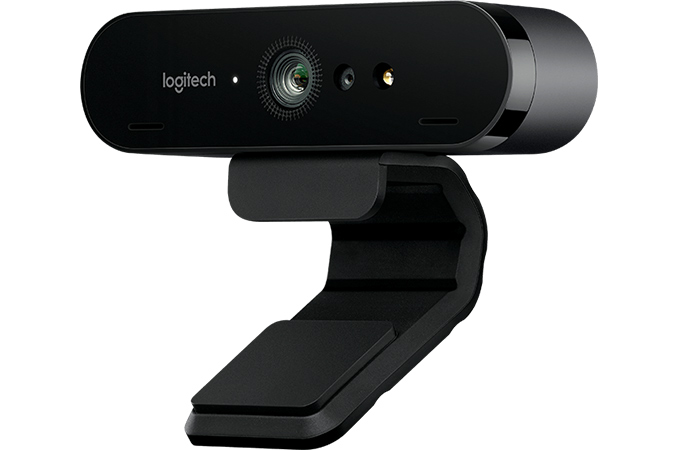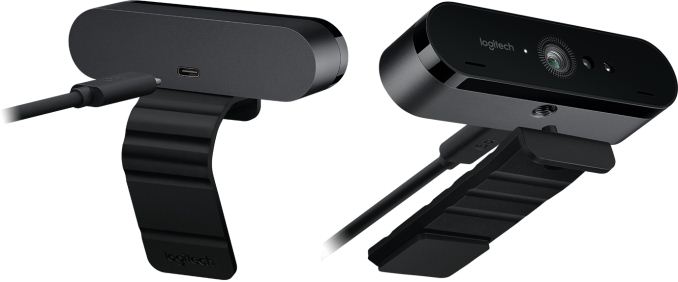Logitech Launches the BRIO 4K Pro: Its First 4K UHD Webcam with HDR
by Anton Shilov on February 8, 2017 8:00 AM EST
Logitech has announced its BRIO 4K Pro Webcam, one of the world’s first webcams that features an Ultra HD resolution as well as HDR. The camera also has an infrared sensor to support facial recognition and Windows Hello.
The Logitech BRIO aka 4K Pro Webcam (960-001105) is based on the company’s new 4K sensor, supports up to 4096×2160 resolution at 30 fps (or 1920x1080 at 60 fps), as well as RightLight 3 with HDR backlighting technology. The webcam has autofocus, 5X digital zoom, and is equipped with an infrared sensor. The BRIO can also select between 65°, 78°, and 90° field of view (FOV) options, and the device has two omni-directional microphones with additional noise cancellation options.
Logitech does not reveal a lot of information about its webcam and we do not know what codec it uses or what video encoder chip is inside. What we do know is that the webcam requires USB 3.0 interconnection for 4K video recording, which suggests that video bitrates it supports are fairly high. As with the recently released C922, the Brio 4K will use Logitech's latest software package which includes background replacement (similar to green screen detection). Logitech also lists a physical external privacy shutter on the feature set, allowing users to visually confirm that the camera is not taking video by other means (although, it is not mentioned if this also physically stops audio recording).
As for compatibility, the Logitech BRIO 4K Pro can work with all modern versions of Windows, Apple’s macOS 10.10 and higher as well as with Google Chrome OS version 29.0.1547.70. In addition, Logitech likes to point out that the webcam is suitable with multiple enterprise-class applications, including Skype for Business and Cisco programs with compatible certifications. It is worth noting that due to various reasons, Windows 7 supports up to 1080p only.
The Logitech BRIO 4K Pro webcam is designed to be attached to the top of a monitor, so weighs 63 grams (2.2 oz) while being 102 mm (4”) wide and 27 mm (1”) tall and 27 mm (1”) deep. The clip weighs 44 grams, making the whole construction around 107 grams total. Logitech lists that the webcam comes with a USB 3.0 Type-A cable, indicating a C-to-A connection rather than a straight C-to-C.
The Logitech BRIO 4K Pro Webcam is available today directly from Logitech.com as well as from the company’s resellers worldwide. The MSRP of the product is $199 in the U.S., £199 in the UK, and €239 in Europe (those last two include tax).
Source: Logitech

















19 Comments
View All Comments
nathanddrews - Wednesday, February 8, 2017 - link
Pretty sure this is just "HDR" combining multiple exposures like my smartphone does, but in real time. It's not the same as HDR found in new games, UHD Blu-ray, Netflix, etc. I would love to be corrected though.fanofanand - Wednesday, February 8, 2017 - link
HDR certainly has become a convoluted technology with all of the variations involved. I believe nathanddrews is correct, I highly doubt a $200 webcam is going to have the ability to shoot in wide color gamut with 1000+nit brightness. Even Samsung's "Premium HDR" doesn't have a wide color gamut nor does it have the required brightness. Now they have "HDR 1000" which is what HDR was supposed to be in the first place. All this nonsense has forced me to put off a TV purchase for 2 years now, maybe 2017 will be the year they get their act together.edzieba - Wednesday, February 8, 2017 - link
"I highly doubt a $200 webcam is going to have the ability to shoot in wide color gamut with 1000+nit brightness."Dynamic Range has no inherent link to colour gamut or absolute illumination levels. Conflating these will only lead to confusion.
nathanddrews - Wednesday, February 8, 2017 - link
Point being that HDR is a buzzword that can sell products to the right audience. Going only by what Logitech has officially stated on its website about this device, it is not the same HDR we see in any of the new HDR standards, whether it's HDR10, HLG, or Dolby Vision. Going by the information provided in the PR and what's on the box, this camera will combine multiple exposures to brighten dark areas and dim bright areas to "compress" into an SDR video stream - which is literally the exact opposite of what "real" HDR does.I'm hoping Logitech will clear this up and release more details. Better yet, I hope Anandtech gets one and tests it thoroughly. :-D
ddriver - Wednesday, February 8, 2017 - link
You can achieve HDR even with the crappiest imaging sensor in existence, it is a simple matter of processing the signal. There is no magic to it, the most expensive professional HDR capable cameras do it the same way. I am not saying that this will do actual HDR, as in output high dynamic range video, it will probably be the same trash every other logitech webcam has been with pathetic software gimmicks to go with it. Actual cost - about 20$ at best, the rest you pay for the brand.Murloc - Wednesday, February 8, 2017 - link
Compressing it afterwards or not is meaningless in the case of a webcam because most people will compress the range since the point of this is using it as a webcam.Still, it's real HDR imaging, the effect of shadows not being so dark anymore is a clear advantage.
nathanddrews - Wednesday, February 8, 2017 - link
Didn't say it was meaningless, just that it's not creating an HDR video stream. What I am saying is that if this works the same way that the HDR mode on my camera works, then it's just an SDR representation of multiple exposure levels. This is no different than when Half Life 2 introduced HDR Rendering to games by brightening dark areas and darkening bright areas - it's not real HDR.niva - Wednesday, February 8, 2017 - link
So you're not saying anything at all, because you really don't know how it works, or exactly what they implemented. You're just guessing.Carry on now.
nathanddrews - Wednesday, February 8, 2017 - link
I'm saying quite a bit, but yes, an educated guess is still a guess.bigboxes - Wednesday, February 8, 2017 - link
Oh, come on now. Exactly how many hardware reviews do you see on the new AnandTech these days? Don't hold your breath.